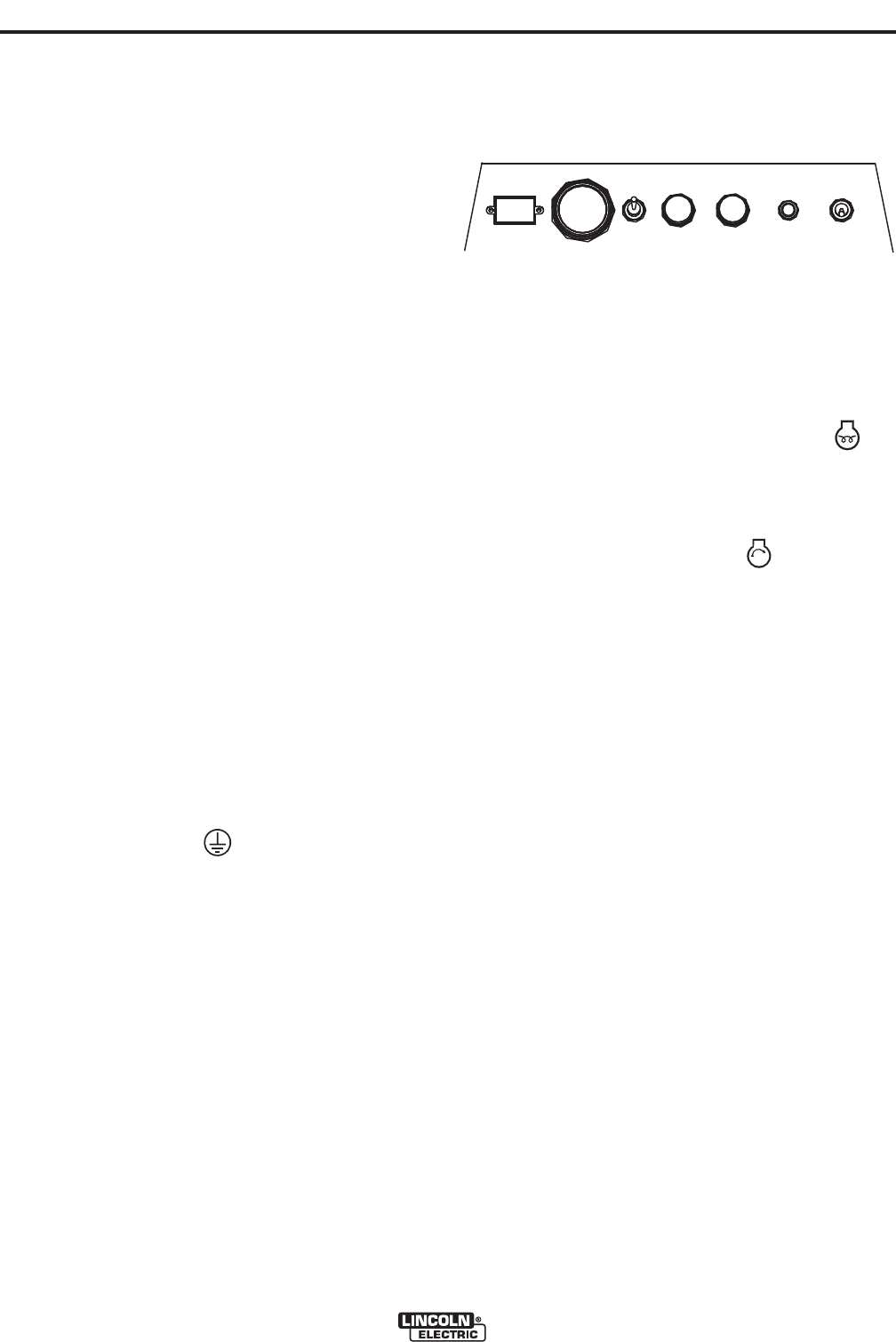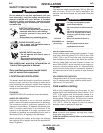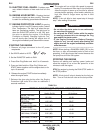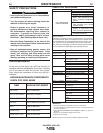
B-3
OPERATION
B-3
4. ARC CONTROL: The ARC CONTROL dial is active in
the CV-WIRE, CC-STICK and DOWNHILL PIPE modes,
and has different functions in these modes. This control is
not active in the TIG mode.
CC-STICK mode: In this mode, the ARC CONTROL dial
sets the short circuit current (arc-force) during stick welding
to adjust for a soft or crisp arc. Increasing the dial from –10
(soft) to +10 (crisp) increases the short circuit current and
prevents sticking of the electrode to the plate while welding.
This can also increase spatter. It is recommended that the
ARC CONTROL be set to the minimum number without
electrode sticking. Start with a setting at 0.
DOWNHILL PIPE mode: In this mode, the ARC CONTROL
dial sets the short circuit current (arc-force) during stick
welding to adjust for a soft or a more forceful digging arc
(crisp). Increasing the number from –10 (soft) to +10 (crisp)
increases the short circuit current which results in a more
forceful digging arc. Typically a forceful digging arc is pre-
ferred for root and hot passes. A softer arc is preferred for
fill and cap passes where weld puddle control and deposi-
tion ("stacking" of iron) are key to fast travel speeds. It is
recommended that the ARC CONTROL be set initially at 0.
CV-WIRE mode: In this mode, turning the ARC CONTROL
clock wise from –10 (soft) to +10 (crisp) changes the arc
from soft and washed-in to crisp and narrow. It acts as an
inductance/pinch control. The proper setting depends on
the procedure and operator preference. Start with a setting
of 0.
5. WELD OUTPUT TERMINALS WITH FLANGE
NUT:
Provides a connection point for the electrode and
work cables.
6. GROUND STUD:
Provides a connection point for connecting the machine
case to earth ground.
7. 14-PIN CONNECTOR: For attaching wire feeder con-
trol cables to the RANGER® 305D (CE). Includes contactor
closure circuit, auto-sensing remote control circuit, and 42V
power. The remote control circuit operates the same as the
6 Pin connector.
Note: The 14-pin connector does not include 120V.
8. 6-PIN CONNECTOR: For attaching optional remote
control equipment. Includes auto-sensing remote control
circuit.
9. WELD TERMINALS SWITCH: In the WELD TERMI-
NALS ON position, the output is electrically hot all the time.
In the REMOTELY CONTROLLED position, the output is
controlled by a wire feeder or amptrol device, and is electri-
cally off until a remote switch is depressed.
10. WIRE FEEDER VOLTMETER SWITCH:
Matches the polarity of the wire feeder voltmeter to the
polarity of the electrode.
ENGINE CONTROLS: (Figure B.2)
11. RUN/STOP SWITCH
- RUN position energizes the
engine prior to starting. STOP position stops the engine.
The oil pressure interlock switch prevents battery drain if
the switch is left in the RUN position and the engine is not
operating.
12. GLOW PLUG PUSH BUTTON -
• When pushed activates the glow plugs. Glow plug
should not be activated for more than 20 seconds
continuously.
13. START PUSH BUTTON -
Energizes the starter motor to crank engine.
14. IDLER SWITCH- Has two positions as follows:
1) In the HIGH position, the engine runs at the high idle
speed controlled by the engine governor.
2) In the AUTO position, the idler operates as follows:
• When switched from HIGH to AUTO or after starting the
engine, the engine will operate at full speed for approxi-
mately 12 seconds and then go to low idle speed.
• When the electrode touches the work or power is drawn
for lights or tools (approximately 100 Watts minimum), the
engine accelerates and operates at full speed.
• When welding ceases or the AC power load is turned off,
a fixed time delay of approximately 12 seconds starts. If
the welding or AC power load is not restarted before the
end of the time delay, the idler reduces the engine speed
to low idle speed.
• The engine will automatically return to high idle speed
when there is welding load or AC power
load reapplied.
RANGER® 305D (CE)


















